Condition states
An ecological model for eucalypt open-forests in Queensland. View a larger image
Depending on its management history, land that once supported eucalypt open-forest may now support the same vegetation, fewer or no trees, a different vegetation type, or no trees at all. These are different condition states for eucalypt open-forests.
The ecological model shown on this page describes the different condition states for eucalypt open-forests, and what led to their formation. It also suggests how a state can be restored back to the ‘mature open-forest state’ (state 1), which is the maximum carbon state.
The main points are:
- Selective clearing, grazing and burning within a mature eucalypt open-forest (state 1) can reduce carbon stocks, and lead to an open-forest with limited tree recruitment (state 2), and sometimes with high densities of shrubs (state 3). Clearing, in combination with grazing and burning, can result in states with canopy trees still present (states 4 and 5), but over time the canopy trees may be completely removed (states 6 and 7).
- To restore to a mature open-forest, understorey shrubs may need to be thinned or removed (states 3, 5 and 7).
- States without a eucalypt seed source (states 6 and 7) will require direct seeding or tubestock planting of canopy tree species.
- These transitions toward higher carbon states will be accelerated if there is adequate rainfall, no clearing and no hot fires. Carbon stocks in a mature eucalypt open-forest (state 1) will be maintained close to their capacity if there is adequate rainfall, no clearing and no hot fires.
- Grazing and timber harvesting should be compatible with carbon farming as long as the dying mature trees are replaced at the same rate by new trees growing into the canopy (see managing tree density).
- The tree density and structure of a reforestation site will depend upon the balance between trees, timber, pasture, wildlife and any other preferences of the manager.
Identify your site’s condition state
To identify the condition state of your site, answer the following questions.
- Are Eucalyptus or Corymbia or Angophora or Lophostemon sp. present, as saplings or mature trees?
- Is a uniformly dense layer of understorey shrubs present (> 50% shrub cover)?
If you answered:
- yes to both questions, you probably have either open-forest with limited tree recruitment and high shrub cover (state 3) or canopy trees present as juveniles and high shrub cover (state 5)
- yes to 1 and no to 2, you probably have either mature open-forest (state 1) or open-forest with limited tree recruitment and low shrub cover (state 2) or canopy trees present as juveniles and low shrub cover (state 4)
- no to both questions, you probably have canopy trees absent and low shrub cover (state 6)
- no to 1 and yes to 2, you probably have canopy trees absent and high shrub cover (state 7).
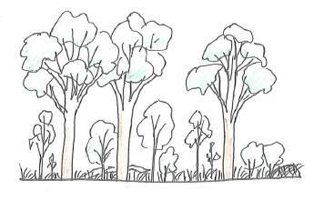
State 1— Mature open-forest
Eucalyptus and/or Corymbia and/or Lophostemon and/or Syncarpia and/or Angophora present as canopy trees (> 2m high) forming an open forest. Ongoing recruitment of canopy trees. Ground layer may be grassy or shrubby, but shrub cover generally < 50%.
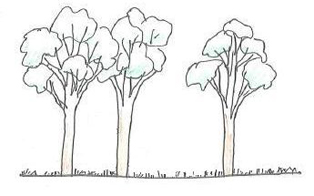
State 2—Open-forest with limited tree recruitment and low shrub cover
Eucalyptus and/or Corymbia and/or Lophostemon and/or Syncarpia and/or Angophora present as canopy trees (> 2m high) forming an open forest. Canopy tree recruitment suppressed by grazing and/or burning. Shrub cover < 50%.

State 3—Open-forest with limited tree recruitment and high shrub cover
Eucalyptus and/or Corymbia and/or Lophostemon and/or Syncarpia and/or Angophora present as canopy trees (> 2m high) forming an open forest. Canopy tree recruitment suppressed by high shrub density. Shrub cover > 50%.
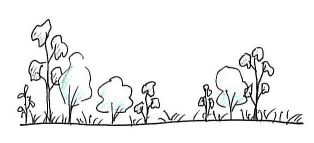
State 4—Canopy trees present as juveniles and low shrub cover
Eucalyptus and/or Corymbia and/or Lophostemon and/or Syncarpia and/or Angophora present as seedlings or saplings. Shrub cover < 50%.

State 5—Canopy trees present as juveniles and high shrub cover
Eucalyptus and/or Corymbia and/or Lophostemon and/or Syncarpia and/or Angophora present as seedlings or saplings. Shrub cover > 50%.
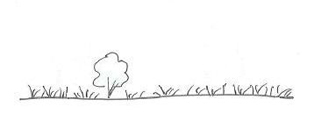
State 6—Canopy trees absent and low shrub cover
Eucalyptus and/or Corymbia and/or Lophostemon and/or Syncarpia and/or Angophora absent, either as trees or juveniles. Shrub cover < 50%.
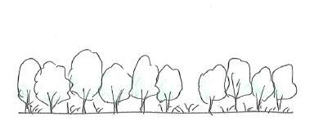
State 7—Canopy trees absent and high cover of shrubs such as wattles
Eucalyptus and/or Corymbia and/or Lophostemon and/or Syncarpia and/or Angophora absent, either as trees or juveniles. Shrub cover > 50%.
Doesn’t seem to fit?
Check the vegetation of your site with the interactive map.
Main management issues
The main management issues for each condition state for eucalypt open-forests are summarised below.
Condition states 1, 2 and 4 have been grouped and condition states 3 and 5 have been grouped because their management issues are the same.
| Condition state | Description | Main management issue |
|---|---|---|
| 1, 2 and 4 | Canopy trees present, low-moderate shrub cover | Areas in these states should require little intervention to sustain or increase their carbon stocks |
| 3 and 5 | Canopy trees present, high shrub cover | High shrub cover may impede the recruitment and replacement of canopy trees |
| 6 | Canopy trees absent, low-moderate shrub cover | Seed sources (and/or tubestock) will be needed to restore canopy trees |
| 7 | Canopy trees absent, high shrub cover | Seed sources (and/or tubestock) and some reduction in shrub cover will be needed to restore canopy trees |


